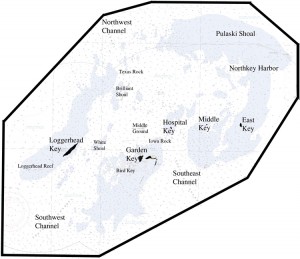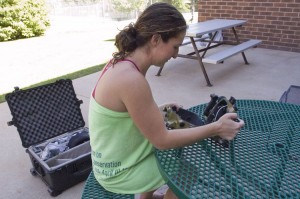After my first few days in Biscayne National Park, I am getting a true taste of what it is like to live and work in South Florida. After stocking up on groceries for my time here, I remember pondering how wonderful it was that I could find mangos, papayas, passion fruits, dragon fruits, and many other tropical delights at the local fruit stand. Unfortunately, being in the tropics comes at a much higher cost then mosquito bites and sunburn. All the tropical fruit in the world seems insignificant when a potential hurricane starts making its way towards you.
On Monday morning I met up with Shelby Moneysmith, the Park Dive Officer and Biological Science Technician, and Dr. Vanessa MacDonough, Fishery and Wildlife Biologist at the park. After getting a tour of the park’s facilities, I headed out on the water with park divers Anthony DiSilvestro and Meghan Balling to monitor the short stretches of available coastline on Elliot Key for sea turtle nests, followed by a couple of dives searching for lionfish. This is about as different as it gets from the Dry Tortugas, for being only 180 miles away (as the crow flies). Biscayne is on the mainland of Florida. You can drive for 10 minutes and be at a grocery store. The shore here is densely populated with mangroves, and near shore waters are often the color of tea, due to tannins released by the decaying vegetation. The smell of mangroves is also distinctive—pungent and organic, you can’t really ignore it, just learn to love it! Not only are there dense mangrove communities, but dense human communities abound nearby as well. Visitors from all over south Florida, including Miami, visit the park, and there is clearly much more human impact out here than in the deserted islands of the Dry Tortugas. Propeller scars in the sea grass, anchor damage on coral reefs, and marine debris are all telling signs of challenges facing park managers. Sensitive and endangered organisms like Manatees, sea turtles, and Elkhorn corals all rely on habitats found within the park, and the difficulties of managing human use of the park and maintaining these habitats in pristine condition are immense.
One of the most obvious challenges the park faces is the significant amount of marine debris that washes ashore here, due to winds and currents. The first time I saw one of the sea turtle beaches I was appalled by the amount of trash these turtles must haul themselves through to nest. Not only that, but the beaches here are lined with craggy, sharp beach rock that can be murderous to human feet. I can only imagine how difficult it would be for a turtle that gets stuck at low tide to crawl back to the water. These are not the powdery soft beaches of the Tortugas. Although there are small numbers of turtles that nest here, despite the harsh conditions, park resource managers have seen a significant decline in nests and an increase in false crawls. It is important for all of us to remember that our waste has a global effect—not only can it end up on turtle beaches and prevent them from nesting, it can end up in the ocean and entangle, poison, choke or otherwise harm wildlife and habitats. The debris that washes up on the shore of Biscayne represents a global epidemic of mismanaged waste, and we all need to do out part to reduce our impact.
Unfortunately, our day was cut short by the looming threat of Hurricane Irene, which on Monday (August 22) appeared as though it might be heading for the east coast of southern Florida. At this point it was only a Tropical Storm, but park managers wanted to play it safe to ensure the safety of park facilities and give the park’s employees enough time to deal with preparing their homes in case the storm hit. We spent the next couple of days battening down the park—taking all the boats out of the water and securing them on their trailers, tidying loose debris and equipment around the exteriors of all the park buildings, and putting up hurricane shutters. I stocked up on water, ice, and food in case we lost power in park housing. By Wednesday(August 24), we were all in a suspended state, waiting to see where Irene would go. I spent the week helping crews prepare for the hurricane, and assisting in the office as needed. The park is currently preparing for a public comment session on the draft General Management Plan (GMP), which will dictate management priorities in the park for the next couple of decades, and I helped out with the creation of a presentation about marine reserves to be used in the public meetings (for more information about the draft GMP, see http://www.nps.gov/bisc/parknews/draft-general-management-plan-released.htm). It was really interesting and informative to get a behind the scenes look what goes into preparing for public meetings, and to see all the different potential alternatives for zoning of the park in the future.
Thankfully, Hurricane Irene headed away from Florida and up the coast on a northern trajectory, although this was quite unfortunate for the northeastern states. By Friday morning we had all the boats back in the water, and were able to go out diving! Anthony, Katie Johnson (Park Biologist), and I went out to search for lionfish. We didn’t have very much luck, and the visibility was awful due to the high winds and thunderstorms all week, but I was just happy to get back in the water. If the weather holds out, I can look forward to lots of diving next week!





































































































